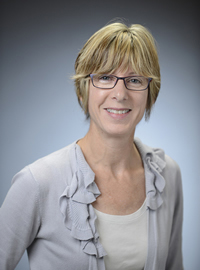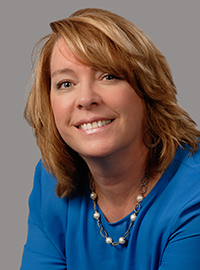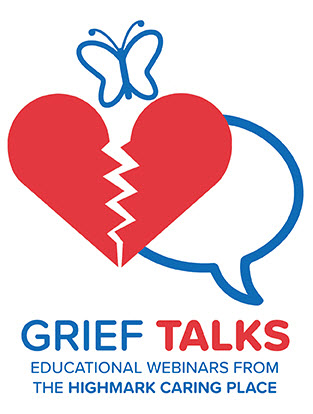The COVID-19 pandemic required businesses, educational institutions, and many other organizations to pivot operations in ways that previously did not seem possible. Highmark’s Caring Place is a good example. For more than two decades, Caring Place centers across Pennsylvania had provided safe, welcoming environments where grieving children, teens and families could share their experiences and feelings, engage in activities, and get support from each other and from specially trained staff and volunteers.
Shifting that in-person model to the virtual world presented many challenges. Andrea Lurier and Terri Bowling, Caring Place program managers, shared their insights on how the team overcame those challenges and developed new possibilities for outreach and support along the way.

Andrea Lurier, program manager and child grief specialist at the Highmark Caring Place.
Catherine Clements: Let’s start by talking about how the Caring Place’s programming shifted over the course of the pandemic. In an earlier interview, Terese LaVallee, director of the Caring Place, outlined several resources, campaigns and efforts to reach people virtually. Could you tell me more about what it was like behind the scenes?
Andrea Lurier: Like most people at Highmark Health and across the country, we were sent home in mid-March of 2020. At some sites, our spring support groups had already started and families were just getting to know each other, and at other sites new groups were about to launch. What was hard is that we didn't know how long the quarantine was going to last, so we weren’t sure what to tell families.
As time went on, it became clear that we wouldn’t be able to do in-person groups for a while. Our director, Terese LaVallee, deserves a lot of credit for advocating early on that we needed to come up with a way to do summer programming online. I admit I was skeptical, because there's something about being in person, in the presence of each other. Being next to children, especially, can be such a calming, organizing experience for them. So there was uncertainty about how online efforts would work, and initially some families said they’d rather wait until we were back in person.
However, we needed to do something, because collectively we were feeling more isolated than ever. Grieving families already feel different and alone, and children may not know anyone else going through the grief they’re experiencing. Social distancing and the pandemic amplified those feelings. The realization we had was, yes, our centers and in-person groups are phenomenal — but it’s the kids, the families, they are the Caring Place, and we can still bring them together online.
Most of us are not tech people, but we all took crash courses in Zoom, Teams, Google — we downloaded every app. We sent a survey to our families to learn what mattered most to them, and then we started with the most efficient efforts first, including building our online presence and a Facebook Forum for our families. There was a flurry of creativity, and our Outreach and Education team hit it out of the park.
Terri Bowling: We learned so much about all our Caring Place teams, and what it means to come together. There really was a collective decision, and commitment, to come together and ask what we could do for our families.
Catherine Clements: How were virtual programs different or more challenging than in-person groups? Were there any observations that stood out to you?
Andrea Lurier: The technology element was a hurdle at first — ensuring everyone could log on to the call, dealing with weak Internet connections. It was very important to map out how our programs could be accessible — thinking about factors like connectivity, whether a family had enough devices, art materials, all the logistics. We were mailing activity kits, we drove computers out to families — I drove up to Armstrong County and sat with a grandmother, socially distant, teaching her how to use the computer. Everybody did that kind of work.
The other observation of note was learning how to pick up on virtual body language. For example, if a child goes off camera, what does that really mean? It could be anything from a technical glitch to “this is hard for me and I don’t want people to see my face” to just needing a break. We had to get really savvy about staying connected to families during the meetings, because we couldn’t just pull them aside to check on them like we would in person.

Terri Bowling, program manager and child grief specialist at the Highmark Caring Place.
Catherine Clements: The Caring Place has physical sites across Pennsylvania in Erie, Harrisburg, Warrendale and Pittsburgh. How did virtual programming create more possibilities for the Caring Place?
Andrea Lurier: For one thing, it allowed us to build grief groups across all four sites, and to be more selective than traditional in-person efforts. We could really tailor groups based on need. For example, an adult who experienced the death of a spouse would likely feel more comfortable speaking to other adults in similar situations. With kids, it allows us to group them closer in age — which for our middle school children makes a big difference.
Additionally, we serve everyone in the family — we built one of the first programs in the country to serve infants, toddlers and preschoolers. Typically, when families are onsite, the preschoolers are in their own room with volunteers and their adults are in a separate group. But the virtual programming allowed us to bring young children and parents together — and we saw a noticeable difference in how the kids expressed themselves with the safety and the assurance of their adult and in the comfort of their own home. I’m really pleased that we had staff that advocated for finding a way to serve all our children.
Terri Bowling: As an example of grouping, I had a powerful experience with a preschool group of five young boys who all lost their fathers. They came from across the state, and I'll never forget that first night that they connected those dots. They all said, “I lost my dad” and “I lost my dad, too.” The way these three-, four- and five-year-olds made the connection — that’s why we’re here, we share this — was astounding.

Virtual options can’t replace in-person Caring Place groups, but they do offer benefits, including being able to create grief groups based on age or shared experiences rather than just physical location.
On the other side of the age spectrum, we recently started programming for ages 18 to 30. I’m a huge advocate for bridging the gap in services for this largely underserved community. We’ve piloted programming for this group for a number of years, but this virtual platform has helped make it a core part of our regular offerings. That’s an important extension of our program.
Going back to accessibility, the in-person connection is so powerful, but there are families where the logistics might make a virtual option better. I had a family tell me that they would have to drive an hour to our facility, an hour home, and then it’d be late getting the kids to bed. For someone like that, a virtual option can make their lives a little easier.
Catherine Clements: What about the support the Caring Place provides to schools — how has that been impacted?
Terri Bowling: Our standing program to support schools is still in place, although it has changed scope a bit, of course. There have been real struggles for most teachers transitioning from a very in-person approach to only being on screen with their students, or to managing a hybrid model. Recognizing a student who might be grieving can be challenging even in person, because there are so many confounding variables. Interacting virtually makes it that much harder.
What hasn’t changed, what I think we've been good at all along, is our focus on providing communication tips and ideas, educational opportunities, and other support that lifts teachers up so they're better prepared to help their students who are grieving. We get consults all the time, and now some of those are around what grieving looks like on screen, or how to reach out and help a student if you have a virtual or hybrid classroom. Our website has a ton of information — toolkits, resources, standard educational programs, training, our Grief Talks educational webinars, all kinds of support, including materials specific to COVID-19.
Andrea Lurier: I’ll just add that each of our sites has dedicated staff whose job is to connect with schools in their region, listen to what their needs are, and provide all those kinds of support. And that has always been flexible — so one school might want us to do a general talk about supporting grieving students, and another school might need support because a teacher or a student died. We’ve developed a lot of great relationships with the schools, and throughout the pandemic, I've been amazed at how many continued to turn to us.

The “Grief Talks” webinar series is one of many ways that Andrea, Terri and other Caring Place experts provide support. Available episodes can be found under “Events” at highmarkcaringplace.com.
Catherine Clements: What about the virtual model could become permanent or impact how the Caring Place operates in the future?
Andrea Lurier: There’s always been discussion of offering support in more regions where Highmark has a presence. When the Caring Place in Pittsburgh started, we soon wanted to connect with Erie, then out in Harrisburg and Warrendale. We’re interested in extending the program in Delaware, West Virginia and New York — and now one possibility might be to do some of that virtually. I will say that, while we’ve had success with online efforts, I don’t think virtual replaces the in-person groups. I see it more as serving different needs.
Terri Bowling: My whole background at the Caring Place has been in outreach and education — so getting the word out there and serving more people. For me, that would include bridging some equity gaps and making sure we serve people that can’t get to us easily, even in areas where we already have a site. Virtual programming is an opportunity to serve a lot of families who wouldn’t necessarily be able to get to us because of transportation and other issues.
There are benefits to both in-person and virtual groups — and giving families the option, or pursuing hybrid models, makes a lot of sense. In my mind, it becomes a menu choice, just giving families more options to better meet their specific needs. Virtual can be part of a great expansion of our program over time, in many different ways — and I’m very excited about that. I love the idea of serving as many people as we possibly can, because there are so many grieving people who need support.